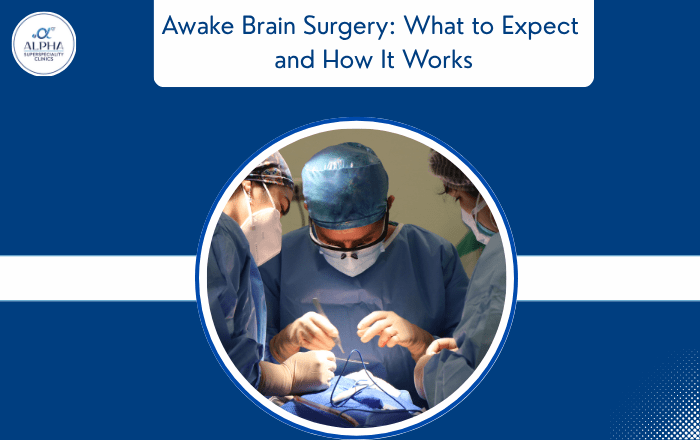Hearing the words “awake brain surgery” can sound a little scary at first. Many people are surprised to learn that it’s possible—and sometimes necessary—to stay awake during brain surgery. But there’s a very good reason for it.
In some cases, the area of the brain being operated on controls important functions like speech, movement, or memory. By staying awake, the medical team can talk to you during the procedure to make sure those critical areas are not harmed.
In this blog, we’ll break down what awake brain surgery is, how it works, what you can expect as a patient, and why it’s used. We’ll also include answers to common questions and introduce you to Dr. Ninad Patil, a trusted brain surgeon in Pune who performs this type of surgery.
What Is Awake Brain Surgery?
Awake brain surgery, also called an awake craniotomy, is a type of brain operation where the patient is kept awake for part or all of the surgery. It may sound unusual, but it’s done to protect the parts of the brain that control speech, movement, and senses.
This procedure is often used to remove brain tumors, especially when they are located near vital areas. It’s also used to treat epilepsy or other brain conditions that require precise navigation around critical functions.
How Awake Brain Surgery Works – Step-by-Step
1. Pre-surgery Evaluation
Before the surgery, you’ll go through various scans like an MRI. These help doctors understand exactly where the problem is and how close it is to areas that control things like speech or movement.
2. Anesthesia and Positioning
You are given local anesthesia to numb the scalp so you won’t feel pain. You won’t be fully asleep; instead, you’ll be in a relaxed, sleepy state at the beginning of the surgery. The doctor will carefully position your head to keep it still during the procedure.
3. Brain Mapping
Once the skull is opened, the surgical team performs brain mapping. This involves gently stimulating small parts of the brain and asking you questions or watching how you move or speak. This helps identify which areas must be avoided.
4. Tumor or Tissue Removal
The doctor then removes the tumor or affected brain tissue while you remain awake. You’ll be asked to speak, move your hands or feet, or perform simple tasks. This helps the team monitor your brain function in real time.
Benefits and Risks of Awake Brain Surgery
Benefits:
- Doctors can avoid damaging areas responsible for speech or movement.
- It allows more of the tumor to be safely removed.
- Patients often recover faster when critical brain areas are protected.
Risks:
- The idea of being awake can be stressful for some people.
- Not everyone is a good fit for this kind of surgery.
- There may be complications like swelling, infection, or seizures, though these are usually rare.
What to Expect as a Patient
Many people wonder what it feels like to be awake during surgery. Surprisingly, most patients say they didn’t feel pain—just some pressure or tugging. You’ll be closely monitored and supported the entire time.
Before Surgery:
- You’ll meet with the surgical team and a psychologist to help you feel prepared.
- You may practice speaking or reading tasks in advance.
During Surgery:
- You’ll be drowsy at first, but the team will gently wake you up when it’s time to monitor your brain activity.
- You’ll talk or move certain parts of your body when asked. This helps the doctors check that everything is going well.
After Surgery:
- Recovery usually involves a hospital stay of a few days.
- You might need speech or physical therapy, depending on the surgery location.
- Most people return to daily activities over the next few weeks or months.
Meet Dr. Ninad Patil – Brain Surgeon in Pune
If you’re searching for a brain surgeon in Pune who performs awake brain surgeries, Dr. Ninad Patil is a well-known name. With years of experience in treating brain tumors and complex neurological conditions, he is known for his detailed approach and calm communication style.
Patients often appreciate how clearly he explains procedures and how he guides them through the journey—from diagnosis to recovery. If you or someone you know needs help with a brain condition, you can consider booking a consultation with him.
FAQ: Common Questions About Awake Brain Surgery
1. Is awake brain surgery painful?
No, local anesthesia is used to make sure you don’t feel pain. You may feel pressure or slight discomfort, but not pain.
2. How long does the awake brain surgery take?
It can take anywhere from 4 to 8 hours, depending on the complexity.
3. Can anyone have awake brain surgery?
Not everyone is a suitable candidate. Doctors assess your health, the tumor’s location, and your ability to stay calm during the surgery.
Awake brain surgery might seem unusual at first, but it has helped many people get treatment while keeping essential brain functions safe. If you’ve been told you need this type of surgery—or are seeking a second opinion—it’s important to speak with a skilled and calm professional.
👉 To learn more or schedule a consultation, you can reach out to Dr. Ninad Patil, brain surgeon in Pune. He can help you understand your condition and guide you toward the right decision for your health.


